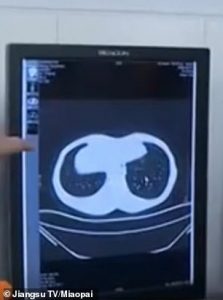Back when we started on our TV cooking video paper about 2000, we were appalled to watch a British celebrity cook drying carrots in the dryer.
 Some of the nearly 1,000 small farmers in New England who grow leafy greens apparently dry the fresh veggies after a triple dip in water in a conventional home washing machine.
Some of the nearly 1,000 small farmers in New England who grow leafy greens apparently dry the fresh veggies after a triple dip in water in a conventional home washing machine.
The spin cycle of a retrofitted washing machine wicks the water off the greens to dry and keep them fresher longer. This discovery by farmers offered a way to automate the drying process without investing in a prohibitively expensive, commercial-grade spinner.
An important question lingers about this practice, which University of Massachusetts Amherst food scientists hope to answer: Is it safe?
“This has been a common practice among small producers of greens,” says Amanda Kinchla, a UMass Amherst extension associate professor of food science. “There are no regulations against this, but there is no data right now on the risk.”
Kinchla, a co-director of the USDA-funded Northeast Center to Advance Food Safety, and UMass Amherst food science colleagues Lynne McLandsborough and Matthew Moore have received a $71,000 grant from the Massachusetts Department of Agricultural Resources and the U.S. Department of Agriculture to study and address the microbial safety risks of processing leafy greens in washing machines. The Northeast Center to Advance Food Safety, led by the University of Vermont, promotes food safety education and technical support to small- and medium-size producers and processors in the northeast region.
The UMass Amherst team is building on work at the University of Vermont Extension, where the agricultural engineering program has been conducting workshops and creating posters for farmers on how to follow a hygienic design to convert washing machines into greens spinners and use them safely.
“My work is more impactful if I can address real-world stakeholder issues and leverage what already has been done,” Kinchla says.
Andrew Chamberlin, UVM Extension agricultural engineering technician, explains that bacteria and grime have the potential to accumulate if farmers don’t know how best to spin the greens and clean the machines. “We are trying to share best practices for food production,” he says.
For example, placing the greens in baskets that fit inside the machine results in fewer points of contact, reducing the risk of contamination, compared with putting the greens directly into the washing machine.
Kinchla’s team has converted four washing machines, based on Chamberlin’s directions, to study in the lab how contamination may occur, what kinds of microbes are present and how best to safely maintain, clean and sanitize the machine.
“We are examining whether the spin cycle on a washing machine has any more risk than commercially available, post-harvest leafy greens spinners,” Kinchla says.













 They then talk about how COVID-19 is affecting essential employees, and what that means for the food industry and supply. Ben and Don talk about what they think about pausing inspections and go into a deep dive about a blip in recalls. The discussion shifts to chicken liver pate and forcemeats. The show ends with the guys talking about Adam Schlesinger and John Prine.
They then talk about how COVID-19 is affecting essential employees, and what that means for the food industry and supply. Ben and Don talk about what they think about pausing inspections and go into a deep dive about a blip in recalls. The discussion shifts to chicken liver pate and forcemeats. The show ends with the guys talking about Adam Schlesinger and John Prine.